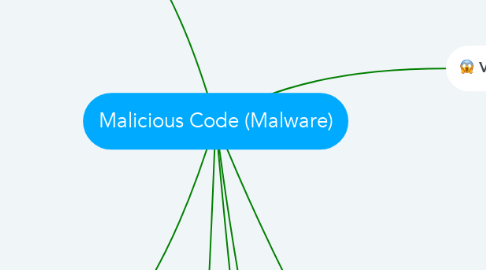
1. Type
1.1. Common Forms
1.1.1. Virus
1.1.1.1. include 2 types
1.1.1.1.1. Transient Virus
1.1.1.1.2. Resident Virus
1.1.1.2. Properties
1.1.1.2.1. Hidden
1.1.1.2.2. self-replicating
1.1.1.2.3. infecting
1.1.2. Worm
1.1.2.1. run independently
1.1.2.2. propagate onto network
1.1.2.3. consume resource
1.1.3. Trojan horse
1.1.3.1. appears as a useful function
1.1.3.2. hidden malicious purpose
1.1.3.2.1. exploit authorization
1.1.3.2.2. sercurity
1.2. Other Types
1.2.1. Zombie
1.2.1.1. computer controlled
1.2.2. Logic Bomb
1.2.2.1. active with condition
1.2.2.2. cause damage resource:dos
1.2.3. Time Bomb
1.2.3.1. like logic bomb
1.2.3.2. active with time
1.2.4. Rabbit
1.2.4.1. type of virus, worm
1.2.4.2. unlimited replicating
1.2.5. Trap door/Back door
1.2.5.1. computer flaw
1.2.5.2. gain access
1.2.6. (Java) Script Attack
1.2.6.1. script language
1.2.6.2. downloaded with webpage
1.3. Targeted Malicous Code
1.3.1. spectify target
1.3.1.1. system
1.3.1.2. application
1.3.1.3. malicious task
1.3.2. stuxnet, flame
2. Attributes
2.1. Harm
2.1.1. negative impact
2.2. Transmission
2.2.1. replicates, speads
2.3. Activation
2.3.1. gain control resource
2.4. Stealth
2.4.1. hide itself
3. Reducing harm form Malware infection
3.1. Serveral mechanism can be used to reduce harm form malware system
3.2. Most single-user system
4. can be malevolent, benign, benevolent
5. Virus
5.1. Perfect Virus
5.1.1. Hard to detect
5.1.2. Hard to destroy/deactive
5.1.3. Spreads infection widely
5.1.4. Can refect programs
5.1.5. Machine and OS independent
5.2. Hiding
5.2.1. boot sector
5.2.2. memory
5.2.3. application program
5.2.4. library file
5.2.5. shared file, program
5.3. Virus Detection
5.3.1. patterns of signature
5.3.1.1. storage
5.3.1.2. execute
5.3.1.3. distribution
5.4. Removal and Post-infection Recovery
5.4.1. fixing system
5.4.1.1. Disinfect viruses
5.4.1.2. Recover/replace file
5.4.2. identifying digital objects modfied
5.4.2.1. error dectecting codes
5.4.2.1.1. parity bits
5.4.2.1.2. checksum
5.4.2.1.3. cryptographic checksum
5.4.2.2. error correcting codes
5.5. Classifying
5.5.1. Appending
5.5.2. Surrounding
5.5.3. Integrating
5.5.4. Replacing

